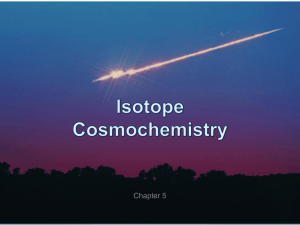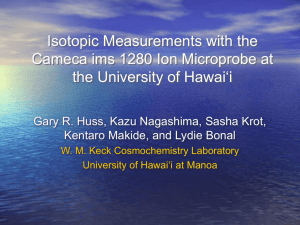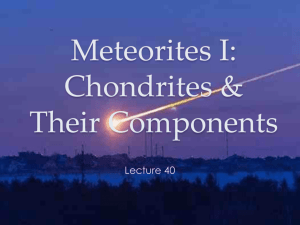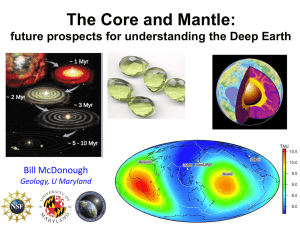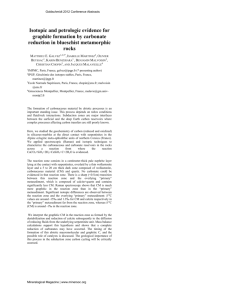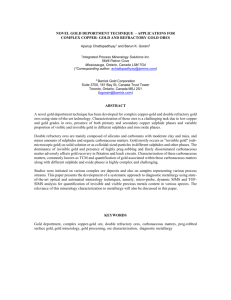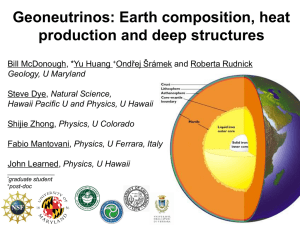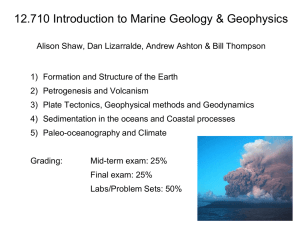DATING THE FIRST STAGE OF PLANET FORMATION. , Qing-zhu Yin Jacobsen
advertisement
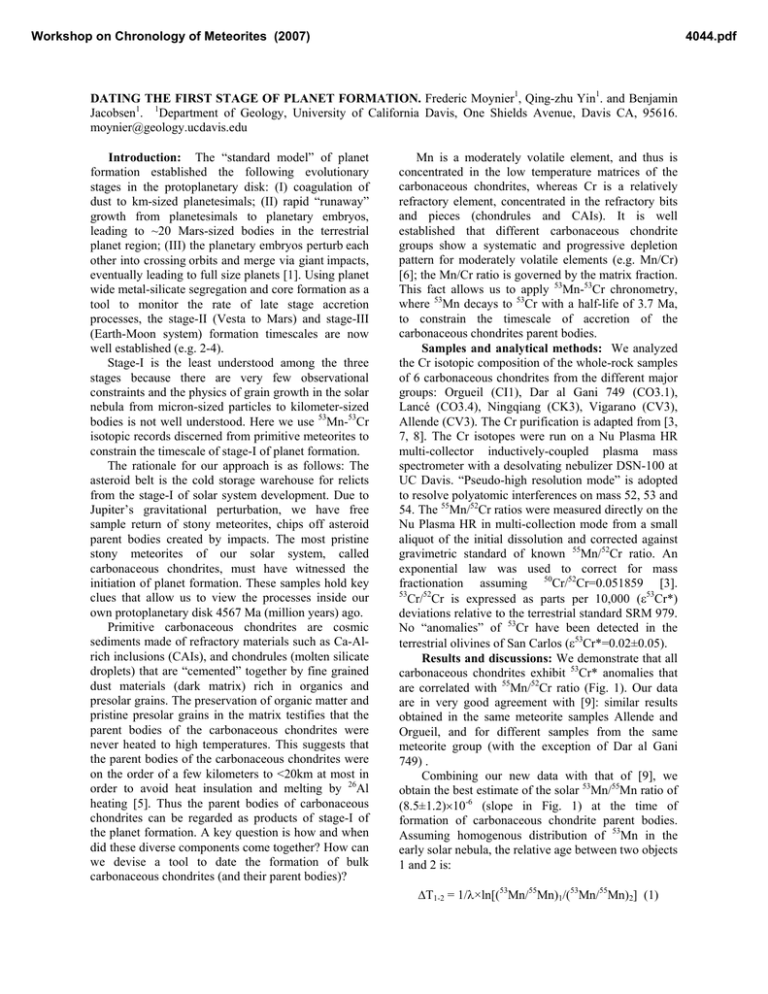
Workshop on Chronology of Meteorites (2007) 4044.pdf DATING THE FIRST STAGE OF PLANET FORMATION. Frederic Moynier1, Qing-zhu Yin1. and Benjamin Jacobsen1. 1Department of Geology, University of California Davis, One Shields Avenue, Davis CA, 95616. moynier@geology.ucdavis.edu Introduction: The “standard model” of planet formation established the following evolutionary stages in the protoplanetary disk: (I) coagulation of dust to km-sized planetesimals; (II) rapid “runaway” growth from planetesimals to planetary embryos, leading to ~20 Mars-sized bodies in the terrestrial planet region; (III) the planetary embryos perturb each other into crossing orbits and merge via giant impacts, eventually leading to full size planets [1]. Using planet wide metal-silicate segregation and core formation as a tool to monitor the rate of late stage accretion processes, the stage-II (Vesta to Mars) and stage-III (Earth-Moon system) formation timescales are now well established (e.g. 2-4). Stage-I is the least understood among the three stages because there are very few observational constraints and the physics of grain growth in the solar nebula from micron-sized particles to kilometer-sized bodies is not well understood. Here we use 53Mn-53Cr isotopic records discerned from primitive meteorites to constrain the timescale of stage-I of planet formation. The rationale for our approach is as follows: The asteroid belt is the cold storage warehouse for relicts from the stage-I of solar system development. Due to Jupiter’s gravitational perturbation, we have free sample return of stony meteorites, chips off asteroid parent bodies created by impacts. The most pristine stony meteorites of our solar system, called carbonaceous chondrites, must have witnessed the initiation of planet formation. These samples hold key clues that allow us to view the processes inside our own protoplanetary disk 4567 Ma (million years) ago. Primitive carbonaceous chondrites are cosmic sediments made of refractory materials such as Ca-Alrich inclusions (CAIs), and chondrules (molten silicate droplets) that are “cemented” together by fine grained dust materials (dark matrix) rich in organics and presolar grains. The preservation of organic matter and pristine presolar grains in the matrix testifies that the parent bodies of the carbonaceous chondrites were never heated to high temperatures. This suggests that the parent bodies of the carbonaceous chondrites were on the order of a few kilometers to <20km at most in order to avoid heat insulation and melting by 26Al heating [5]. Thus the parent bodies of carbonaceous chondrites can be regarded as products of stage-I of the planet formation. A key question is how and when did these diverse components come together? How can we devise a tool to date the formation of bulk carbonaceous chondrites (and their parent bodies)? Mn is a moderately volatile element, and thus is concentrated in the low temperature matrices of the carbonaceous chondrites, whereas Cr is a relatively refractory element, concentrated in the refractory bits and pieces (chondrules and CAIs). It is well established that different carbonaceous chondrite groups show a systematic and progressive depletion pattern for moderately volatile elements (e.g. Mn/Cr) [6]; the Mn/Cr ratio is governed by the matrix fraction. This fact allows us to apply 53Mn-53Cr chronometry, where 53Mn decays to 53Cr with a half-life of 3.7 Ma, to constrain the timescale of accretion of the carbonaceous chondrites parent bodies. Samples and analytical methods: We analyzed the Cr isotopic composition of the whole-rock samples of 6 carbonaceous chondrites from the different major groups: Orgueil (CI1), Dar al Gani 749 (CO3.1), Lancé (CO3.4), Ningqiang (CK3), Vigarano (CV3), Allende (CV3). The Cr purification is adapted from [3, 7, 8]. The Cr isotopes were run on a Nu Plasma HR multi-collector inductively-coupled plasma mass spectrometer with a desolvating nebulizer DSN-100 at UC Davis. “Pseudo-high resolution mode” is adopted to resolve polyatomic interferences on mass 52, 53 and 54. The 55Mn/52Cr ratios were measured directly on the Nu Plasma HR in multi-collection mode from a small aliquot of the initial dissolution and corrected against gravimetric standard of known 55Mn/52Cr ratio. An exponential law was used to correct for mass fractionation assuming 50Cr/52Cr=0.051859 [3]. 53 Cr/52Cr is expressed as parts per 10,000 (ε53Cr*) deviations relative to the terrestrial standard SRM 979. No “anomalies” of 53Cr have been detected in the terrestrial olivines of San Carlos (ε53Cr*=0.02±0.05). Results and discussions: We demonstrate that all carbonaceous chondrites exhibit 53Cr* anomalies that are correlated with 55Mn/52Cr ratio (Fig. 1). Our data are in very good agreement with [9]: similar results obtained in the same meteorite samples Allende and Orgueil, and for different samples from the same meteorite group (with the exception of Dar al Gani 749) . Combining our new data with that of [9], we obtain the best estimate of the solar 53Mn/55Mn ratio of (8.5±1.2)×10-6 (slope in Fig. 1) at the time of formation of carbonaceous chondrite parent bodies. Assuming homogenous distribution of 53Mn in the early solar nebula, the relative age between two objects 1 and 2 is: ΔT1-2 = 1/λ×ln[(53Mn/55Mn)1/(53Mn/55Mn)2] (1) Workshop on Chronology of Meteorites (2007) where λ is the decay constant of 53Mn. By comparing the initial 53Mn/55Mn ratio of (8.5±1.2)×10-6 with (1.25±0.07)×10–6 of angrite LEW86010 [3], a ΔTcc+0.87 /-0.75 Ma is deduced. The absolute Pbangrites of 10.2 Pb age of this angrite is 4557.8±0.5 Ma [10], thus an absolute age of 4568.0+0.91/-1.17 Ma for the carbonaceous chondrite is derived. This age is very similar to Pb-Pb ages obtained on CAI fragments (4567.2 ± 0.6 Ma) from the CV3 chondrite Efremovka [11]. The age deduced from the initial 53Mn/55Mn ratio for the bulk carbonaceous chondrites is the same as that for the CAIs, therefore the formation of the first solid igneous objects as well as the accretion of the undifferentiated kilometer-sized carbonaceous chondrite parent bodies must have been complete within +0.91 to -1.17 Ma at 4568 Ma ago. This estimate conservatively includes both uncertainties of the Fig. 1 isochron and the absolute age anchor for angrite LEW86010 [10]. This is currently the best estimate for the stage-I planet formation timescale. Fig. 1. 53Mn-53Cr fossil isochron diagram for bulk carbonaceous chondrites. Red solid circles are new data from UC Davis. Blue solid squares are from recent data of [9]. These data collectively suggest that carbonaceous chondrite parent bodies must have been accreted within -0.73 to +0.84 Myr, as defined by the uncertainty of this whole rock isochron. The maximum duration is thus <1.57 Myr. The logical necessity that chondrules formed first in order to form chondrites means that the data also constrains chondrule formation (for carbonaceous chondrite) to be within +0.91 to -1.17 Ma at 4568 Ma ago. Since CAIs are just as old (4567.2±0.6 Ma) , we predict that a more precise dating of chondrules in carbonaceous chondrites in future studies will confirm the above conclusion. This would eliminate the longstanding puzzle known as the “storage problem” faced by the current prevailing chronological data, namely, how could mm- to cm-cized CAIs float in the solar nebula for over 2 Ma, relative to chondrules, without spiraling into the Sun? 4044.pdf Delayed chondrule formation for ordinary chondrites: Yin et al [12] report the chondrules from a primitive ordinary chondrite (Chainpur LL3.4) with 53 Mn/55Mn = (5.1±1.6)x10-6. Compared to bulk carbonaceous chondrite initial 53Mn/55Mn = (8.5±1.2)x10-6, chondrules in ordinary chondrites are younger by 2.7-1.6/+2.3 Myr. Distinct Cr Isotopic Reservoirs in the Early Solar System: Importantly, the initial μ53Cri=8.7±9.1 ppm (μ = 100ε) for Chainpur chondrules [12] is clearly higher than bulk carbonaceoous chondrites initial μ53Cri=-19.6±7.4 ppm (Fig. 1), strongly suggesting they are coming from two isotopically distinct reservoirs. This is consistent with the bulk ordinary chondrites (ε53Cr*=0.48±0.03, 55Mn/52Cr= 0.76) [13] plotting above the bulk carbonaceous chondrite isochron. Bulk enstatite chondrites (ε53Cr*=0.16, 55 Mn/52Cr = 0.76) [13], on the other hand, plot below the isochron in Fig. 1. Abee (EH4), the oldest among the three enstatite chondrites, is 5.6-1.0/+1.2 Myr younger than carbonaceous chondrites based on its 53Mn/55Mn= (3.0±0.4)x10-6 and μ53Cri=-3±6 ppm. Bulk Earth with (55Mn/52Cr)BE=0.19 [14] and ε53Cr*=0 plots on the bulk carbonaceous isochron within the error envelop of the regression line in Fig. 1 and given the uncertainty of (55Mn/52Cr)BE estimates. In contrast, Bulk Silicate Earth plots below the isochron, given the range of estimate for (55Mn/52Cr)BSE = 0.35-0.45 [14, 15], requiring substantial fraction of Cr must have been partitioned into the core. Mars also plots below the isochron, using (55Mn/52Cr)Mars = 0.76, and ε53Cr*=0.22 [3]. References: [1] J.E. Chambers, Earth EPSL, 223, 241 (2004). [2] Q.-Z. Yin et al., Nature, 418, 949 (2002). [3] G.W. Lugmair, A. Shukolyukov, GCA, 62, 2863 (1998). [4] S.B. Jacobsen, AREPS., 33, 531 (2005). [5] I.S. Sanders, G.J. Taylor ASPCP, 241, 915 (2005). [6] J.T. Wasson, G.W. Kallemeyn, PTRSL, 325, 535 (1988). [7] J.L. Birck, C. J. Allègre, GRL., 12, 745 (1984). [8] D. P. Glavin et al., MAPS. 39, 693 (2004). [9] Shukolyukov, G.W. Lugmair, EPSL, 250, 200 (2006). [10] G.W. Lugmair, S.J.G. Galer, GCA, 56, 1673 (1992). [11] Y. Amelin et al., Science, 297, 1678 (2002). [12] Q.-Z. Yin et al., ApJL, 662, L43. [13] A. Shukolyukov and G.W. Lugmair (2004) GCA, 68, 2875-2888. [14] W.F. McDonough, (2003) TOG, 2, 547-568. [15] S.R. Hart. And A. Zindler,. (1996) CG,. 57, 247-267.
